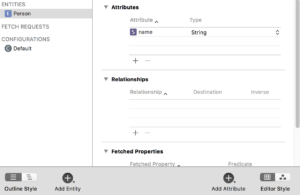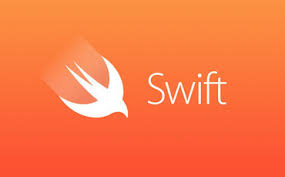[swift] Add / Delete Tasks with CoreData
for Add / Delete Tasks with CoreData, Refer below code
with Closure, Run Reload Table or fetch CoreData, Once Save/Delete method has been completed
Add CoreData after creating xcode Project without CoreData
目次
Create CoreData
Create Data Model File

Create new file with “New File” (CoreData -> Data Model)
Data Model file name is “HitList”, then file named “HitList.xcdatamodeld” in xcode Project
Create Entity & Attribute
in this case, Create Entity (DB table in SQL) named “Person” and Attribute (Column in SQL) named “Name” within “Person” Entity
with “Add Entity”, Create “Person” Entity
with “Add Attribute”, Create “Name” Attribute

AppDelegate.swift
Add below code into AppDelegate.swift
- when create project with CoreData, these code will be generate automatically
Should add Data Model name into on “NSPersistentContainer”
// MARK: - Core Data stack
lazy var persistentContainer: NSPersistentContainer = {
/*
The persistent container for the application. This implementation
creates and returns a container, having loaded the store for the
application to it. This property is optional since there are legitimate
error conditions that could cause the creation of the store to fail.
*/
let container = NSPersistentContainer(name: "HitList")
container.loadPersistentStores(completionHandler: { (storeDescription, error) in
if let error = error as NSError? {
// Replace this implementation with code to handle the error appropriately.
// fatalError() causes the application to generate a crash log and terminate. You should not use this function in a shipping application, although it may be useful during development.
/*
Typical reasons for an error here include:
* The parent directory does not exist, cannot be created, or disallows writing.
* The persistent store is not accessible, due to permissions or data protection when the device is locked.
* The device is out of space.
* The store could not be migrated to the current model version.
Check the error message to determine what the actual problem was.
*/
fatalError("Unresolved error \(error), \(error.userInfo)")
}
})
return container
}()
// MARK: - Core Data Saving support
func saveContext () {
let context = persistentContainer.viewContext
if context.hasChanges {
do {
try context.save()
} catch {
// Replace this implementation with code to handle the error appropriately.
// fatalError() causes the application to generate a crash log and terminate. You should not use this function in a shipping application, although it may be useful during development.
let nserror = error as NSError
fatalError("Unresolved error \(nserror), \(nserror.userInfo)")
}
}
}
ViewController.swift
Install TableView on ViewController
with fetchPersonData, retrieve NSManagedObject from CoreDate, then add NSManagedObject into Array named “people”
NSManagedObject is “Dictionary” type. You can access each element with below code
cell.textLabel?.text = person.value(forKeyPath: “name”) as? String
import UIKit
import CoreData
class ViewController: UIViewController {
@IBOutlet weak var tableView: UITableView!
var people: [NSManagedObject] = []
override func viewDidLoad() {
super.viewDidLoad()
title = "The List"
tableView.register(UITableViewCell.self,
forCellReuseIdentifier: "Cell")
}
override func viewWillAppear(_ animated: Bool) {
super.viewWillAppear(animated)
fetchPersonData(){
self.tableView.reloadData()
}
}
@IBAction func addName(_ sender: UIBarButtonItem) {
let alert = UIAlertController(title: "New Name",
message: "Add a new name",
preferredStyle: .alert)
let saveAction = UIAlertAction(title: "Save", style: .default) { [unowned self] action in
guard let textField = alert.textFields?.first,
let nameToSave = textField.text else {
return
}
self.saveName(name: nameToSave){
self.fetchPersonData() {
self.tableView.reloadData()
}
}
}
let cancelAction = UIAlertAction(title: "Cancel",
style: .default)
alert.addTextField()
alert.addAction(saveAction)
alert.addAction(cancelAction)
present(alert, animated: true)
}
func save(name: String) {
guard let appDelegate = UIApplication.shared.delegate as? AppDelegate else {
return
}
let managedContext = appDelegate.persistentContainer.viewContext
let entity = NSEntityDescription.entity(forEntityName: "Person",
in: managedContext)!
let person = NSManagedObject(entity: entity,
insertInto: managedContext)
person.setValue(name, forKeyPath: "name")
do {
try managedContext.save()
people.append(person)
} catch let error as NSError {
print("Could not save. \(error), \(error.userInfo)")
}
}
}
// MARK: - UITableViewDataSource
extension ViewController: UITableViewDataSource {
func tableView(_ tableView: UITableView,
numberOfRowsInSection section: Int) -> Int {
return people.count
}
func tableView(_ tableView: UITableView,
cellForRowAt indexPath: IndexPath) -> UITableViewCell {
let person = people[indexPath.row]
let cell = tableView.dequeueReusableCell(withIdentifier: "Cell",
for: indexPath)
cell.textLabel?.text = person.value(forKeyPath: "name") as? String
return cell
}
func tableView(_ tableView: UITableView, commit editingStyle: UITableViewCellEditingStyle, forRowAt indexPath: IndexPath) {
if editingStyle == .delete {
let person = people[indexPath.row]
deleteName(managedObject: person){
self.fetchPersonData(){
self.tableView.deleteRows(at: [indexPath], with: .fade)
self.tableView.reloadData()
}
}
}
}
}
//MARK: Controll CoreData
extension ViewController {
func saveName(name: String, completion: (()->Void)?) {
guard let appDelegate =
UIApplication.shared.delegate as? AppDelegate else {
return
}
let managedContext =
appDelegate.persistentContainer.viewContext
let entity =
NSEntityDescription.entity(forEntityName: "Person",
in: managedContext)!
let person = NSManagedObject(entity: entity,
insertInto: managedContext)
person.setValue(name, forKeyPath: "name")
do {
try managedContext.save()
completion?()
} catch let error as NSError {
print("Could not save. \(error), \(error.userInfo)")
}
}
func fetchPersonData(completion: (()->Void)?) {
guard let appDelegate =
UIApplication.shared.delegate as? AppDelegate else {
return
}
let managedContext =
appDelegate.persistentContainer.viewContext
let fetchRequest =
NSFetchRequest(entityName: "Person")
do {
people = try managedContext.fetch(fetchRequest)
completion?()
} catch let error as NSError {
print("Could not fetch. \(error), \(error.userInfo)")
}
}
func updateName(managedObject: NSManagedObject, newName: String, completion: (()->Void)?) {
guard let appDelegate =
UIApplication.shared.delegate as? AppDelegate else {
return
}
let managedContext =
appDelegate.persistentContainer.viewContext
do {
managedObject.setValue(newName, forKey: "name")
try managedContext.save()
completion?()
} catch {
}
}
func deleteName(managedObject: NSManagedObject, completion: (()->Void)?) {
guard let appDelegate =
UIApplication.shared.delegate as? AppDelegate else {
return
}
let managedContext =
appDelegate.persistentContainer.viewContext
do {
managedContext.delete(managedObject)
print("deleteName")
try managedContext.save()
completion?()
} catch {
print("deleteName error")
}
}
}

